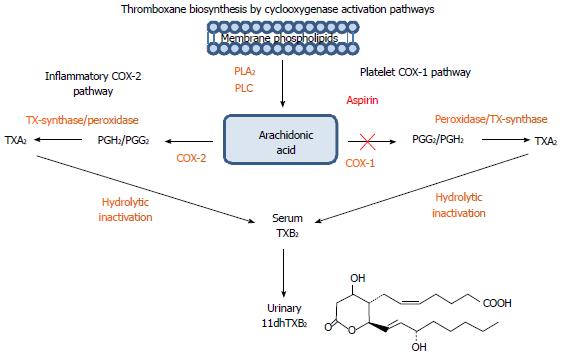Copyright
©2014 Baishideng Publishing Group Co.
World J Diabetes. Apr 15, 2014; 5(2): 115-127
Published online Apr 15, 2014. doi: 10.4239/wjd.v5.i2.115
Published online Apr 15, 2014. doi: 10.4239/wjd.v5.i2.115
Figure 1 A schematic representation of the arachidonic/thromboxane metabolic pathway: Arachidonic acid generated from membrane phospholipids by phospholipase A2 and phospholipase C undergoes additional enzymatic transformation by cyclooxygenases (COX-1 and COX-2) into prostaglandin and thromboxane metabolites.
In platelets, Arachidonic acid (AA) is metabolized by COX-1 into prostaglandins PGG2, PGH2 and by thromboxane synthase into the bioactive thromboxane A2 (TXA2), which is a potent activator of platelet aggregation with a short half-life. TXA2 is quickly inactivated into a more stable thromboxane B2 (TXB2) and converted in the liver into an 11-dehydro-thromboxane B2 (11dhTXB2) metabolite excreted in the urine. Aspirin (ASA) irreversibly inhibits platelet COX-1 leading to decreased thromboxane-mediated platelet activation. TXA2 and 11dhTXB2 can be generated by COX-2 present in various inflammatory cells, pathway not affected by ASA.
- Citation: Lopez LR, Guyer KE, Torre IGDL, Pitts KR, Matsuura E, Ames PR. Platelet thromboxane (11-dehydro-Thromboxane B2) and aspirin response in patients with diabetes and coronary artery disease. World J Diabetes 2014; 5(2): 115-127
- URL: https://www.wjgnet.com/1948-9358/full/v5/i2/115.htm
- DOI: https://dx.doi.org/10.4239/wjd.v5.i2.115









